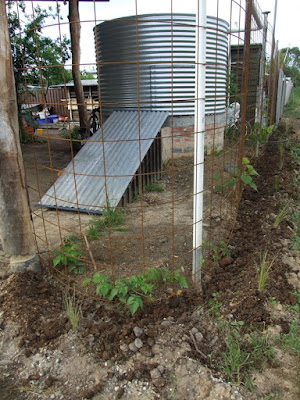Principle 3: Obtain a yield
Boysenberries can be a great producer, or a big problem, it all depends on management. My gardening mentor Brian has been advising me on how to make the most of these prolific plants, and suggested growing them on mesh, which doubles as a fenceline whilst supporting the downpipe to rainwater tank. The mesh supports a sultana grape vine, male and female kiwi fruit vines along with about 7 metres (2.4m high) of boysenberries. The trench on the laneway side of the mesh has small check dams within it to hold water so that the water can seep into the ground rather than run off which reduces the need to irrigate them so often.
Boysenberries require frequent maintenance, but not much of it. This is best done using leather gloves, as the tiny prickles can be quite painful if they break off in your skin. The main task is to feed new growth through the mesh, and remove excess leaders before they get out of control. The images below show the growth and management over the past 18 months. My management style is evolving as I go.
 |
| Boysenberries planted end of Spring and fertilsed with horse manure. Native grasses planted on laneway side, providing mulch, habitat and buffer (from traffic, herbicide runoff and invasive grasses. |
 |
| Canes are threaded through mesh in an ad-hoc fashion as they grow through summer. |
 |
| Most of the leaves drop off during winter, the rest are removed by hand to reduce habitat for berry eating insects |
 |
| During Spring growth resumes and the growth on the canes were prunned to 300mm above ground level to reduce habitat for insects / mould. The native grass was cut back to provide mulch and better access for prunning canes. |
 |
| Thick new growth consumes the mesh and flowers mid Spring. New canes begin to grow from base and are left to grow at ground level. |
 |
| Heavy cropping from late Spring till early summer. Averaging half a bucket a day for many weeks during peak. |
Having such huge yields over a short period meant that we had to find creative uses for the fruit.
- We ate what we could straight from the canes
- We made berry smoothies
- Preserved about 20 large jars of them in water
- Made about 20 jars of jam of various sizes, some given away at Christmas
- Froze some in containers - best to use the containers that they were picked into as they don't transfer well. Very nice with cream or ice cream.
- Made about 15 stubbies (375ml) of berry / plum purée mix as the wild plums were coming on at the same time
- Made about 15 stubbies of berry / plum cordial
- Gave away some fresh berries to our neighbours and friends
 |
| Preserved berries stored in cellar. |
 |
| Old growth pulled from mesh when finished fruiting (early summer) and cut for mulch, took a couple of hours. New cane growth led up mesh, one per vertical - not ad-hoc as per last season. |
 |
| Early Autumn - When canes reach the top they are tipped out and horizontal growth led through mesh to fill in gaps. |












Comments
Best regards, the Kings.